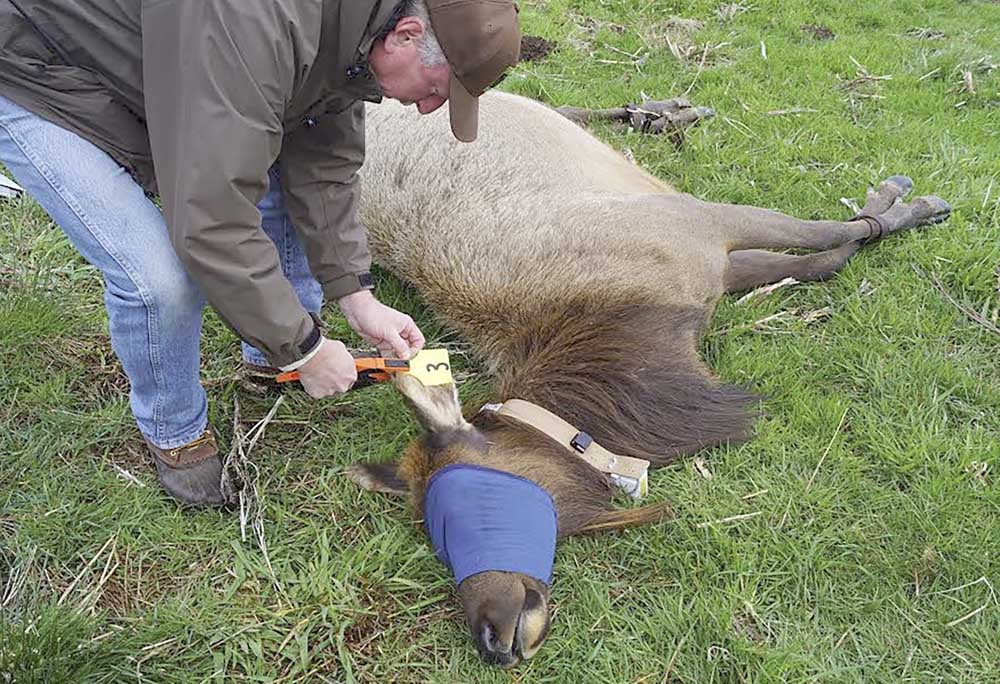Elk project receives state support
Published 3:00 pm Monday, May 6, 2019

- Herman Biederbeck, wildlife biologist with the Oregon Department of Fish and Wildlife, fixes an ear tag onto an elk that has been fitted with a GPS collar to track its movements around Lewis and Clark National Historical Park near Warrenton.
Gov. Kate Brown gave her stamp of approval to a project that will look for solutions to elk and human conflicts in Gearhart and Warrenton.
The governor designated the Clatsop Plains Elk Collaborative as an official Oregon Solutions project at the end of April, opening the door for state funding, as well as boosting the priority of the work. The collaborative will include stakeholders such as private and public property owners, residents, city leaders and wildlife regulators.
The designation signals to state agencies that “this is a project that’s important to Oregon,” said Karmen Fore, director of Oregon Solutions, which is based out of Portland State University’s National Policy Consensus Center.
Gearhart and Warrenton have struggled with how to address conflicts between people and growing elk herds on the Clatsop Plains.
“The purpose of this is to find a solution, a pathway forward,” Warrenton Mayor Henry Balensifer said.
He will serve as a neutral convener for the group, along with Seaside Mayor Jay Barber.
“The point is to create solutions that either don’t exist or are tailored to the nature of the problem locally,” Balensifer said.
With Oregon Solutions’ help, “I think it will be a more diverse discussion which will allow for more creative solutions,” he added.
Elk herds historically roamed the Clatsop Plains, but face a very different landscape now.
Elk pose public safety hazards when they cross major roadways like U.S. Highway 101. Visitors often stop on the sides of roads to gawk at the animals and sometimes walk up to them to take pictures. People have reported run-ins with protective mother elk while walking beach trails in Gearhart, as well as property damage.
Both Warrenton and Gearhart have bans against feeding wildlife to try to curb unsafe elk-human interactions.
Any solutions the Clatsop Plains Elk Collaborative lands on could have statewide implications, especially in other communities where, like the Clatsop Plains, there is little public land and state agencies are limited in what they can do to regulate herds.
“Whatever we create or decide out of this will have more significance statewide,” Balensifer said, adding, “Whatever we do will be a template.”
Oregon Solutions is still reaching out to stakeholders and plans to hold a meeting soon, though the date has not been set.
Meanwhile, other groups are already trying to get a better handle on how elk move through the lands around Warrenton.
Lewis and Clark National Historical Park secured funding to fit up to six elk with GPS collars this year. With assistance from the Oregon Department of Fish and Wildlife, they have tagged four elk so far, according to Chris Clatterbuck, the park’s chief of resource management.
The work is on hold for the calving season, but the elk collared include two cows from a herd that roams park and pastureland north of Fort Clatsop and two from a herd at Camp Rilea.
The focus is on elk that use the national park. Elk were an important source of food and materials for native tribes, as well as for the park’s namesakes, the explorers Meriwether Lewis and William Clark.
“Unfortunately, we won’t learn much about the Gearhart herd,” Clatterbuck said. “What we will learn is if elk that are using the park are also getting into human-elk conflicts in (Warrenton’s) urban areas.”
Collaring only began several weeks ago, but Clatterbuck hopes to build up more extensive data over time. The collars last for up to three years and ping the locations of elk back to the park every 13 hours.
There are already signs that the elk may not appreciate this probing into their private wanderings, however.
Park staff set two collars out on posts on a hillside above South Clatsop Slough to test network signals and make sure the collars would work in the field.
The next morning, they found the collars had been knocked to the ground. They were covered in elk hair and surrounded by fresh elk droppings and hoof prints.
“So we know it was the elk kind of nosing about,” Clatterbuck said. “It would have been nice if they’d put the collars on themselves at the time, but that was too much to ask.”


